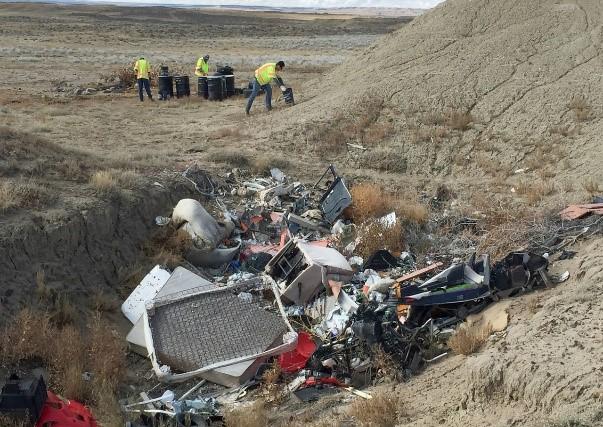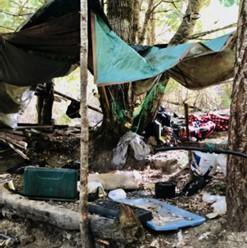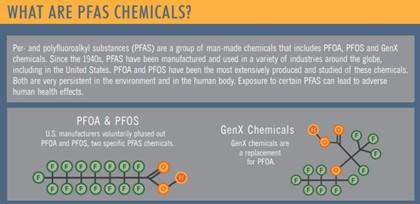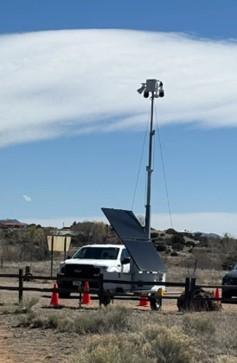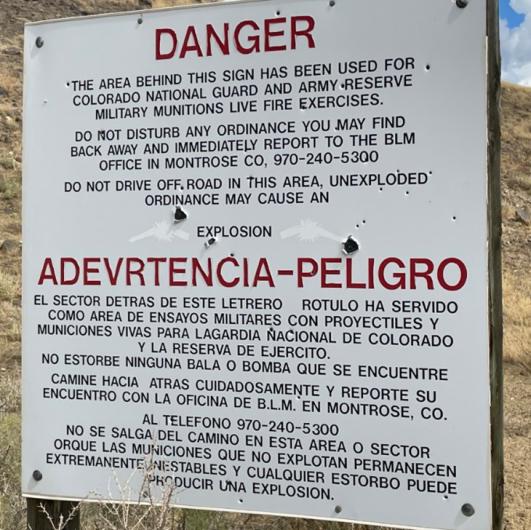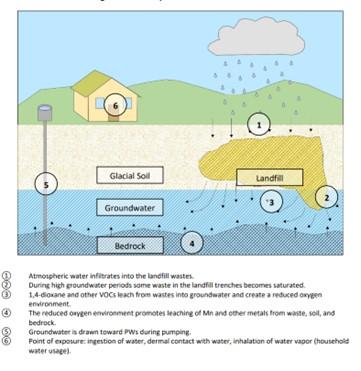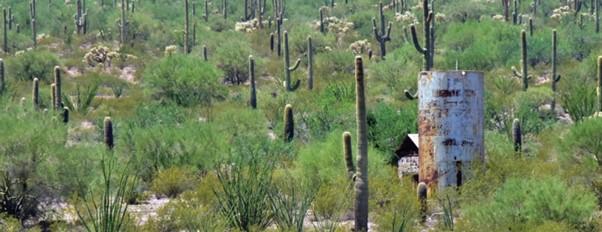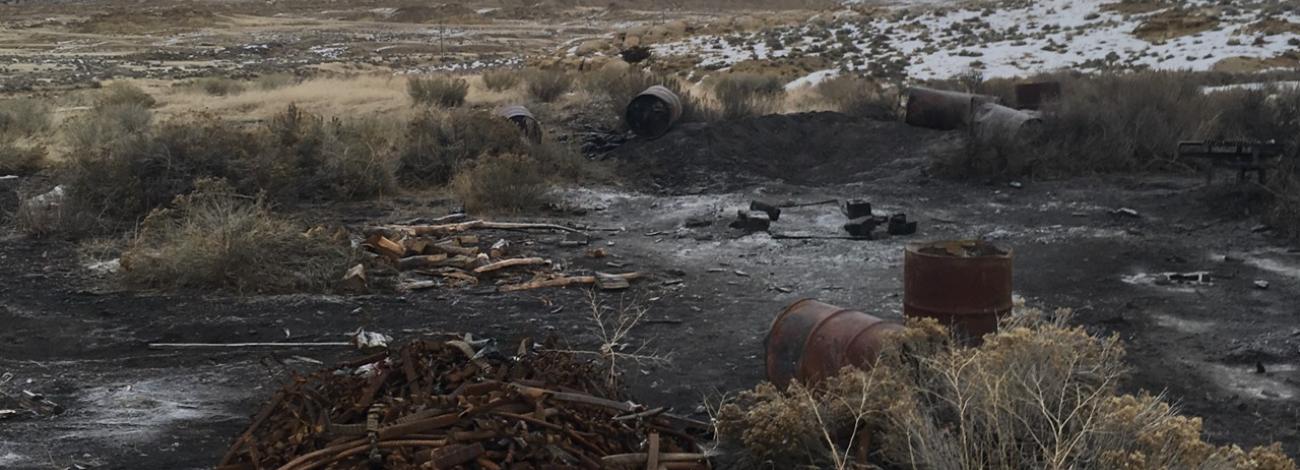
Hazardous Material Management
Day-to-day BLM operations use items such as solvents, cleaning solutions, paints, pesticides, herbicides, compressed gases, batteries and battery electrolytes, fuels and lubricants, and wood preservatives that are typically hazardous materials and may become hazardous wastes when disposal is considered. Compliance with the HMM requirements under the various laws and regulations, and BLM policies is embedded in BLM operations. The HMM program works in cooperation with other BLM programs to prevent releases of hazardous materials and to mitigate the hazards of legacy sites.
In addition, BLM managed lands include lands with hazardous materials from past or unauthorized activities not associated with BLM. These lands include illegal/trespass dump sites, abandoned vehicles, clandestine drug operations, chemical spill sites, and legacy sites, such as abandoned industrial facilities and former military areas. Seemingly benign and beautiful locations, such as lighthouses, may harbor fuel storage tanks and years of lead-based paint accumulation.
Some of the more challenging aspects of the program are discussed in the links below. Some of the challenges are the consequence of trespass and illegal activities onto BLM lands. For the most current information for reporting natural resource crimes on BLM managed lands see the BLM Law Enforcement program page.
Unauthorized Disposal Sites (aka, Illegal Dumping)
Clandestine dumping, trespass, and illegal dumping (the most common term) are used to describe the abandonment of unwanted materials on BLM lands by the public. The sites range from one time dumping from dispersed camp sites to long-term disposal sites for nearby communities and agricultural, commercial, and industrial type activities. Such dump sites often encourage or engender additional illegal dumping in the same area.
Caution must be used in approaching these abandoned waste materials. The hazard of these sites may be compounded by their use as shooting areas and ad hoc material recovery sites, such as wire burn areas and scavenging locations.
Drug Labs and Marijuana Grow Sites
Illegal drug operations have been known to exist on BLM managed lands for some time. In recent years what were once small local operations have expanded into large scale production facilities. The hazardous material problems associated with these operations have increased with the size of the operations.
The HMM program supports law enforcement officers at these sites All chemicals and other materials used in these operations must be treated with caution and properly disposed of by personnel trained and experienced in hazardous material management. Subsequent to the disposal of hazardous materials, the HMM program further investigates these sites for contaminated soils and may perform further site cleanup.
If you encounter one of these areas, leave immediately. These who participate in these types of activities may become hostile and resistant to any outside presence. Please report the sites to local law enforcement and nearest BLM office.
Emerging Contaminants
Emerging contaminants are chemicals and materials not currently (or only recently) regulated that have been detected in environmental monitoring and may pose newly identified or re-emerging risks to human health or the environment. Emerging contaminants include natural or manufactured chemicals and substances, such as those used in pharmaceuticals, pesticides, plastics, and other industrial and commercial chemicals. Most recently, attention is focused on per-and polyfluoroalkyl substances (PFAS) because of their prevalence in consumer products (such as Teflon), their persistent presence in the general population and the relative uncertainty of risk and toxicity of these compounds. These contaminants have broad implications for the BLM HMM Program. Materials and their waste products not previously considered hazardous may be classified as such and their management included in the HMM program and in environmental response actions.
Wind, Solar, and Renewable Energy Sources
In addition to the surge in large-scale renewable energy projects, renewable energy sources are being used in BLM operations and users of BLM lands other than the energy generation sector (such as remote site power supplies, including use by recreational campers). In addition, dumping of expended and unwanted items is a common problem on BLM lands.
The BLM renewable energy program is managed within HQ 300, Energy, Minerals, and Realty management, which requires proper management of hazardous materials and wastes and remediation of environmental liabilities. The HMM program has oversight of the disposal of unneeded, end-of-life, and potentially hazardous wastes.
Like all energy production technologies, when wind turbines solar panels, energy system storage batteries, and wind turbines reach the end of their useful lives, their associated wastes must be responsibly managed. Some solar panels and batteries contain enough metals, like lead, to meet the definition of hazardous waste under the Resource Conservation and Recovery Act when disposal is required.
These technologies are evolving. The storage and disposal requirements will need to be reviewed as that evolution occurs and our state of knowledge advances (such as the outcomes of the studies of lithium as an emerging contaminant). In addition, the construction and maintenance of renewable energy systems may use hazardous materials and generate hazardous wastes.
Legacy Sites, Acquired and Released Lands, and Returned Lands
The BLM accepts into its public land inventory locations that were once used by the private sector, state and local governments, and other Federal agencies.
BLM also releases lands to these same entities. The HMM Program works with the BLM Division of Lands, Realty and Cadastral Survey to identify environmental liabilities prior to acquiring properties and to meet the Comprehensive Environmental Response, Compensation and Liability Act (CERCLA), (42 United States Code (U.S.C. § 9601 et seq.) requirements for Innocent Landowners, Standards for Conducting All Appropriate Inquiries and other policy and guidance.
Where contamination is found on BLM managed lands from past or current activities of non-BLM entities, BLM HMM Program works with the Department of Interior to identify the responsible parties and to have party responsible parties perform or reimburse the Government for the needed environmental response actions. At locations where both BLM managed lands and privately owned lands are involved, BLM may work with the U.S.EPA to oversee or perform the response action. BLM may take on the response action if no responsible party can be identified or the responsible party cannot pay the costs.
Examples of response actions on legacy Sites, acquired Lands, and returned lands include BLM excavating a small fuel spill at the historical Rohn Roadhouse on the Iditarod Trial in Alaska; performing lead paint abatement at former Coast Guard lighthouse in Florida and Washington; overseeing the removal of fuel from a commercial fishing boat shipwreck in the California Coastal National Monument; remediating groundwater at a former refinery in Montana; and collaborating on a multiple party cleanup of hexavalent chromium from the Pacific Gas and Electric Company (PG&E) Topock Compressor Station in California. (The issues posed by county and municipal landfills, such as the groundwater remediation at a former county landfill in Colorado, are a rising challenge that is addressed under the landfill tab).
In the case of former military sites and military activities, the Department of Defense (DoD) has undertaken performing the necessary response actions with oversight by the BLM. These lands comprise five million acres that may contain industrial and commercial type activities that used hazardous materials and training and testing areas unique to the military. These areas are generally accessible to the public and may contain munitions and explosives which pose hazards to BLM staff and volunteers and the users of the lands.
Examples of these areas include the Sonoran National Monument that incorporates a portion of the former Barry M Goldwater Range in Arizona; Bradshaw Trail National Back Country Byway bordering the Chocolate Mountain Aerial Gunnery Range, and the Fort Ord National Monument in California; and the Pony Express National Historic Trail within BLM lands containing the Yellow Jacket Target Area in Utah.
The key role of the BLM in working with the DoD and managing these areas is to follow the 3Rs published by DoD: Recognize, Retreat, and Report. Of the three, “Recognize” may be the most difficult to perform. Retreat and report are recommended when encountering questionable objects in former training and testing areas and adjacent lands.
Landfills and Former Solid Waste Disposal Areas
BLM does not operate solid waste landfills. It is also BLM policy to not renew and, if possible, to terminate Recreation and Public Purposes (R&PP) landfill leases per BLM Handbook-2740 Recreation and Public Purposes, Chapter X (includes alternatives to leases). However, there are remaining R&PP landfill leases and there have been exceptions to the BLM policy regarding existing and new leases. There are also landfills on lands returned to BLM, such as the Park County (Fairplay) landfill in Colorado; Sunrise Mountain landfill in Nevada; the Lee Acres Landfill in New Mexico; the Oroville landfill in Washington; and numerous others. In addition, there are also former industrial area dumps, community and residential trash dump sites, ad hoc fill sites, burn sites, and other solid waste disposal sites that were abandoned before the new regulations came into effect in the 1980s. Some of the old industrial landfills (fortunately none on BLM lands) have become infamous, such as Love Canal.
The old landfill sites are often not recorded and may contain hazardous and toxic wastes; hence they pose similar issues as illegal dump sites. Some waste constituents may migrate to groundwater over time. Disturbance of these sites may also release materials such as asbestos that might not otherwise pose a hazard. Emerging contaminants concerns (see the Tab) may also create a need to investigate and possibly remediate these sites. Such possibilities should be considered in land use planning.
BLM policy is to work with landfill owners and operators to ensure that regulatory requirements are met on those landfills located on BLM lands. These requirements are typically those of the state within which the landfill is located and modeled on the Resource Conservation and Recovery Act (RCRA). If the state does not have an U.S. EPA-approved landfill permitting program, the Federal RCRA requirements are followed. The HMM Program supports the efforts of the efforts of the BLM Lands and Realty Division in working with landfill issues.
When landfills or other solid waste disposal sites are improperly closed and abandoned, the HMM Program works with the involved realty office and the DOI Office of Solicitors to identify a Potentially Responsible Party and pursue their undertaking or cost reimbursement for environmental response actions. When necessary, the HMM program will determine the liability and plan, budget, and implement some or all the environmental response actions needed at a site if a responsible party cannot be found or cannot pay or pay in full.

